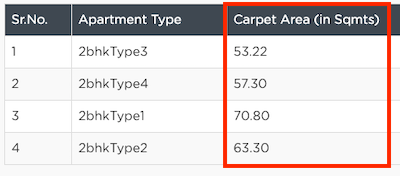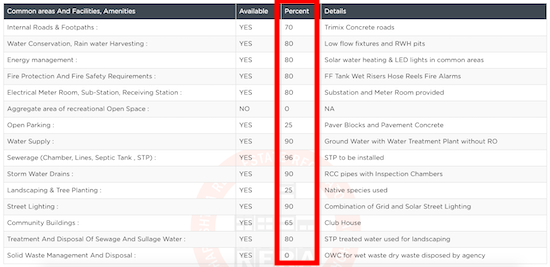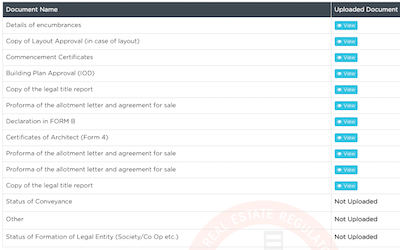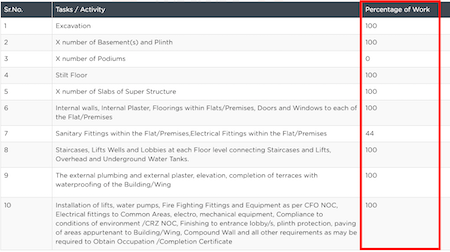How the information stated in RERA website helps the potential home buyers? Before we go into those details I would like to say that the presence of RERA (a regulator) itself is a big “protection” for the home buyers.
Real Estate Regulatory Authority (RERA) acts as a regulator of the real estate sector in India. Before year 2016 there was no regulator. But now there is a regulator and home buyers can use RERA website to get authentic info about the new properties on sale.
Why protection was necessary? Because it was becoming common to see unscrupulous builders cheating the buyers by project delays, ever changing project master-plan, bad construction quality etc.
In last decade, the situation became so bad in India that bringing a full time regulator of the sector (RERA) was the only logical solution left with the Government.
RERA’s website
Now RERA is in place since May’2016. How home buyers can benefit from it? The immediate benefit is in the form of RERA’s website. Though there is no centralised website of RERA, but state wise websites are in place:
| States & UT | RERA’s Websites |
| Delhi | dda.org.in/rera/index.aspx |
| Maharashtra | maharera.mahaonline.gov.in |
| Tamil Nadu | tnrera.in/index.php |
| Karnataka | rera.karnataka.gov.in |
| Uttar Pradesh | up-rera.in |
| Gujarat | gujrera.gujarat.gov.in |
| Madhya Pradesh | rera.mp.gov.in |
| Andhra Pradesh | rera.ap.gov.in |
| Odisha | orera.in/ |
| Bihar | nagarseva.bihar.gov.in/rerabihar |
| Rajasthan | rera.rajasthan.gov.in |
| Jharkhand | rera.jharkhand.gov.in |
| Uttarakhand | uhuda.org.in/real-estate-act |
| Punjab | rera.punjab.gov.in |
| Chhattisgarh | rera.cgstate.gov.in |
| Haryana | harera.in |
| Telangana | rera.telangana.gov.in |
| Himachal Pradesh | hprera.in |
| Goa | rera.goa.gov.in |
| Chandigarh | rera.chbonline.in |
| Andaman and Nicobar Islands | tnrera.in |
Out of all these above websites, the best managed RERA website is of Maharashtra’s Government (maharera.mahaonline.gov.in). Hence I have decided to pick examples from this website. I am sure that other states will duly follow the same in times to come.
RERA registered projects
Which property must be registered with RERA?
- Property having area more than 500 sqm, or
- Property having more than 8 apartments.
If I am not wrong, this virtually will cover more than 95% of all residential projects in India.
Builders whose projects are bigger than the above mentioned criteria, shall register their projects with RERA.
When the promoter must register their project? Before they start advertising & selling the units of the project.
What happens after a project gets registered with RERA? Once a project gets registered, it has to follow the ‘rules” set by the regulator. One of the rule is, ‘declaration of details of the project‘.
These details of any residential project registered with RERA are available on the respective state’s RERA website (listed above).
These are not just any details, they work as the “builders declaration” to the regulator to get the registration. How does it help?
Even if the builder wants, they cannot change the declared details at their free will. In most cases, the promoter/builder will be vetted with respect to their declaration verses actual performance.
Which are the details available on RERA’s website?
This is where the RERA website becomes most utilitarian. This is like having all necessary information related to the property (except price) at one pit-stop. And the best part is, RERA’s website is a perfect report card of the builder. How? This is what we will see in this article.
Here are few points which will explain how RERA website will help a home buyers in times to come…
#1. The problem of “delay in getting possession” of the property is addressed.
While the builder/promoter is applying for the registration to RERA, they must submit an affidavit declaring the completion date. This date in turn will be displayed in the RERA website.

Under RERA Act builders are more likely to complete their work in time, instead of opting for the usual “indefinite delays“. Why? Because there will be penalty levied in case of delays.
The penalty will be in the form of interest payable by the builder to the buyers. The rate of interest to be paid will be ‘home loan interest offered by SBI, plus 2%‘. Moreover, in extreme cases there can also be jail sentence for the builder/promoter.
On part of the builders, this will be a huge burden. They are most likely to complete the projects on time, or seek formal deliver extensions.
Getting a delivery extension under RERA act is not easy for builder/promoters.
#2. The problem of hidden “carpet area” is addressed.
How many times people end-up buying a property considering its built-up area as a usable area? More often than we can imagine.
For novice buyers the concept of carpet area, built-up area, and super built-up area can be confusing. So in the offer document, when they see a large area shown as built-up and super built-up area, they mistakenly confuse it as “carpet area”.

Under RERA, this confusion is eliminated once and for all. How? Henceforth, properties cannot be sold based on super built-up area. The buyers will now pay the price based on carpet area only.
This will also make price comparison (Rupees per unit carpet area) more relevant between similar apartments of different projects.
How RERA website will help in this regard? The “carpet area” of each type of residential apartments within a project will be displayed in RERA’s website.

But what if the builder/promoter decides to change the “carpet area” itself in the middle of execution? They can’t do it. If at all it is necessary, they will have to first take consent from the buyers (at least two-third majority).
#3. The buyers can keep a watch on progress of work of “common facilities”.
Builders may cheat the buyers by making the apartments ready, but not providing the necessary amenities like electricity, water, swage disposal etc.
But now on RERA website, the progress of work of ‘common facilities’ as well will be visible. It is mandatory for the builders to report this progress to RERA every quarter.

#4. Buyers will know the “status of booked apartments” of the project.
For prospective new buyer, this information can be very useful. Why? Because it is good to buy a property in a project which has more buyers. Such projects generally do not get stalled.
In the website of RERA, there is a clear comparison between the number of available apartments verses booked.
This information will also give the clarity to the buyer that, since launch, how many apartments has been booked as on date.
If not many apartments are booked, buyer may take it as a leverage for price negotiations etc. In most cases, a weak order book may also indicate “bad market” or “bad reputation” etc.

#5. Projects getting stalled due to absence of “necessary approvals” will not be the case.
There are several projects which are launched by the builders, and later get stalled. Why? Mainly because the corporation has stopped the work as the builder has not taken necessary approvals.
Which are these approvals?
- Environmental clearance.
- Layout approval.
- Allotment Letter.
- Agreement of Sale.
- Commencement Certificate etc.
Under RERA Act, no builder will get the registration for the specific project till necessary approvals are taken. Moreover, a copy of all such approved documents shall be handed over to RERA which will later be loaded on RERA website for buyers information.

#6. Buyers will know the “progress of work” in detail
For understanding of common men, RERA has formulated a standard progress report for the under construction property. This standard report gives a clear visualisation of the progress of work as on the reported date.
How is the progress report structured? It shows percentage progress of work based on the following milestones:
- Excavation.
- Basement & Plinth Level.
- Stilt / Ground Floor Level.
- Slabs of all above ground floors.
- Work between internal walls of all floors.
- Sanitary Fittings.
- Common Area Civil work (Stair case, lifts, lobby, corridor etc).
- External work on the building.
- Installation work (like lifts, electrical system, utility system, paving, roads, boundary walls etc.)

#7. ‘Past Experience Details’ of the Builder/Promoter.
This is one of my favourite information available on the RERA’s website. Why? Because it helps the buyer to gauge how reliable is the builder/promoter.
The experience detail listed here works like a report card for the promoter. What we shall see in the report card?
- Name & Address of the past projects.
- Size of the past projects (one can compare this with the project in consideration).
- Proposed vs actual date of completion.
This status report will help the buyer to decipher a more competent builder/promoter from the rest.

#8. Other important advantage of ‘RERA Act’ for the buyers…
One of the biggest advantage of RERA act is in how it allows the builders/promoters to use the collected funds from the buyers.
RERA dictates that the fund allocated for a specific project shall not be used elsewhere. How it assures the prevention of fund diversion?
By creating a rule which states that 70% of the total money collected from the buyers shall be deposited in an escrow account.

Once the collected money goes into the Escrow Account, the funds are released to the builder/promoter based on the declaration given by the builder to the RERA and Bank, confirming the “stage of construction“.
Why RERA was so specific on fund use? Because in the past, it was observed that the project’s execution was getting delayed because promoters/builders were diverting the funds of one project to other new projects.
Conclusion
For prospective home buyers, RERA’s website is like a gift made in heaven. I’m exaggerating? Probably yes, but ask people who are facing difficulties with the project delays etc. Had the ‘RERA Act’ been in place before 2016-17, the same builders would have been more accountable.
RERA puts so much information on display for the public that, the same builders who were playing tricks before will find it safe to do business more fairly.
The information which is available for public on RERA website is the key. This is what is going to make all the difference in times to come. Moreover, with a regulator like RERA in place, real estate sector will hopefully align itself and do a more honest business.
New property buyers, whether they are investing in land, commercial project, or a residential project, better will be to go only for RERA registered properties. Why?
Because one can check online the necessary details of RERA registered properties and take a more informed investment decision.





Nice blog thank you for sharing this blog it was very helpful. Do check our website.
I read your article it’s fabulous. Thanks for sharing this article. Keep on sharing this kind of article. Keep us more updated.
I read your article it’s fabulous. Some of my friends and relatives are really searching for this information. So I’m sharing these articles with them. So they too get the benefit. Thanks for sharing this article. Keep on sharing this kind of article. Keep us more updated.
A very informative article about RERA act and how it can be used by home buyers. Author did lot of research before writing this article. Hats off to his work. Just I want to confirm, Will be same RERA rules applicable to Jammu and Kashmir real estate sector?
This makes for a very informative read. Shall help prospective buyers greatly.